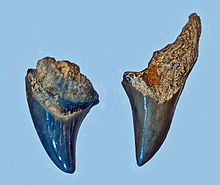Parotodus
| Parotodus | |
|---|---|

| |
| Fossil teeth of Parotodus benedenii | |
| Scientific classification | |
| Domain: | Eukaryota |
| Kingdom: | Animalia |
| Phylum: | Chordata |
| Class: | Chondrichthyes |
| Subclass: | Elasmobranchii |
| Subdivision: | Selachimorpha |
| Order: | Lamniformes |
| Family: | incertae sedis |
| Genus: | †Parotodus Cappetta, 1980 |
| Type species | |
| †Parotodus benedenii Le Hon, 1871
| |
| Species | |
| |
Parotodus, commonly known as the false-toothed mako shark (or false mako shark), is an extinct genus of
Description
Initially appearing as a small shark, Parotodus gradually increased in size over geologic time and by the Neogene period became one of the largest sharks of its time.[4] A 1999 study estimated the genus to have measured up to 7.6 meters (25 ft) in length.[5] The teeth of Parotodus are distinctively curved and rarely show feeding damage, which suggests that it mainly preyed on soft-bodied animals. Paleontologists speculate that this included other sharks, including the contemporaneous Megalodon.[6]
Classification
Due to the general scarcity and ambiguity of fossils, the
Currently, three valid species are generally recognized within Parotodus. These include P. benedenii, P. pavlovi, and P. mangyshlakensis. However, some scientists, especially those who identify Parotodus as a cardabiodont, do not recognize the latter two as members of the genus.[4]
A fourth species was reported by Ward, Nakatani, and Bernard in a 2017 poster from the Oligocene of Japan. The poster stated that the new species is to be named after Yasuhiro Fudouji, the paleontologist who discovered the type specimens, and will be formally described in an upcoming paper. However, the scientific name was not explicitly stated to avoid an accidental invalidation of the taxon.[6]
Fossil records

The genus is often regarded as a rare species despite its presence in ocean deposits worldwide. As a result, it is often prized by fossil collectors. Paleontologists believe that Parotodus likely inhabited primarily open oceans like the modern oceanic whitetip shark and blue shark. This would explain why fossils of a cosmopolitan animal are so rare, given that open oceans are seldom represented in terrestrial fossil deposits. This hypothesis is additionally supported by how Parotodus teeth are unusually common in nodule deposits under the Pacific and Indian Oceans and on islands located far away from continental lands.[4]
Parotodus fossils have been recovered from fossil deposits in the Azores, Mallorca, Malta, Europe, Madagascar, Kazakhstan, Japan, South Korea, South Africa, New Zealand, Australia, Peru, California, the East Coast of the United States, and dredged from the Pacific and Indian Oceans.[4][8]
References
- ^ Iserbyt, A.; De Schutter, P.J. (2012). "Quantitative analysis of Elasmobranch assemblages from two successive Ypresian (early Eocene) facies at Marke, western Belgium". Geologica Belgica. 15 (3): 147–156.
- ^ Steurbaut, E. (2006). "Ypresian". In Dejonghe, L. (ed.). Current status of chronostratigraphic units named from Belgium and adjacent areas. Vol. 9. pp. 73–93.
{{cite book}}:|journal=ignored (help) - .
- ^ a b c d e Canevet, J. (2019), "Le genre Parotodus: le faux requin-mako", Fossiles (in French), no. 37, pp. 39–50
- ^ Kent, B.W. (1999). "Speculations on the Size and Morphology of the Extinct Lamnoid Shark, Parotodus benedeni (le Hon)" (PDF). The Mosasaur. 6: 11–15.
- ^
- )
- .
See also
- List of prehistoric cartilaginous fish
